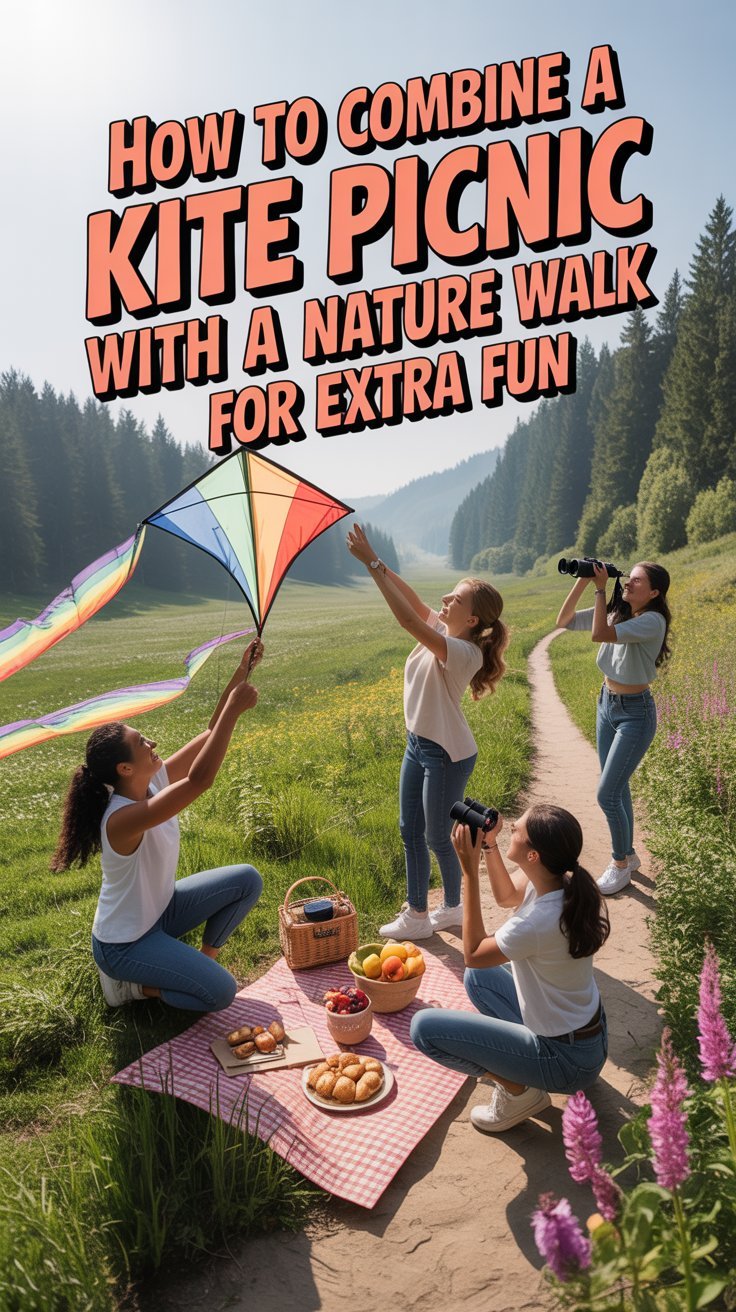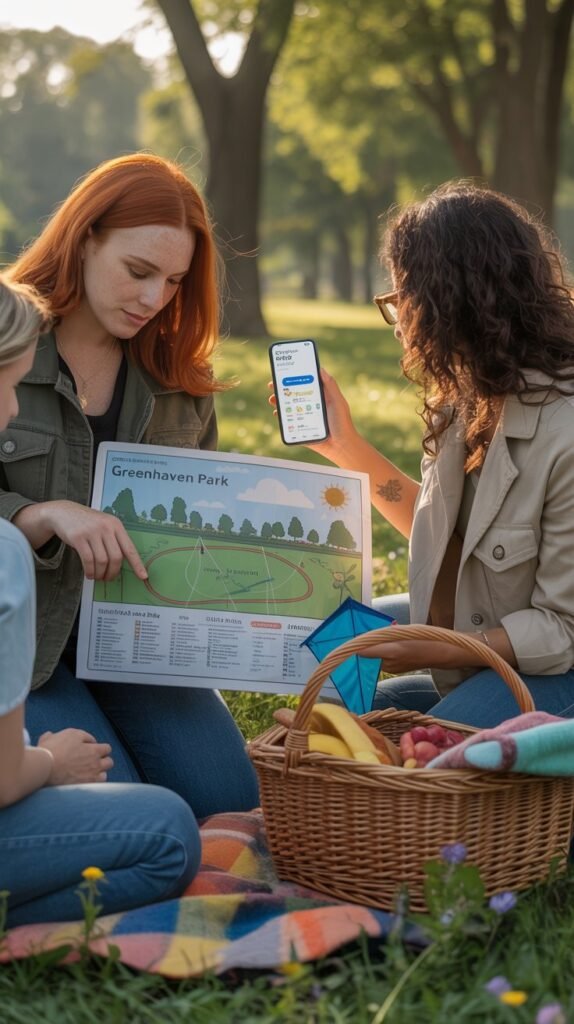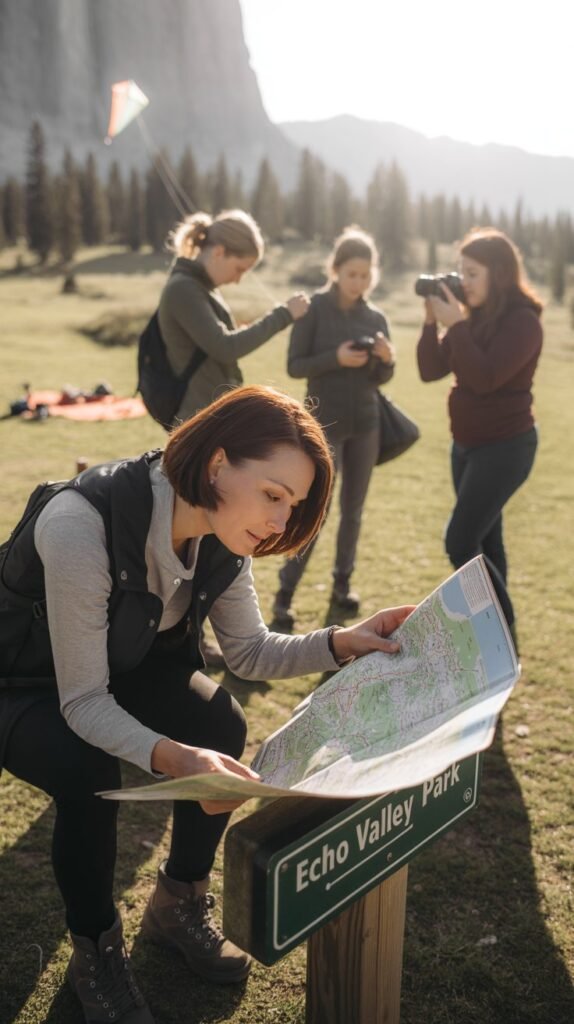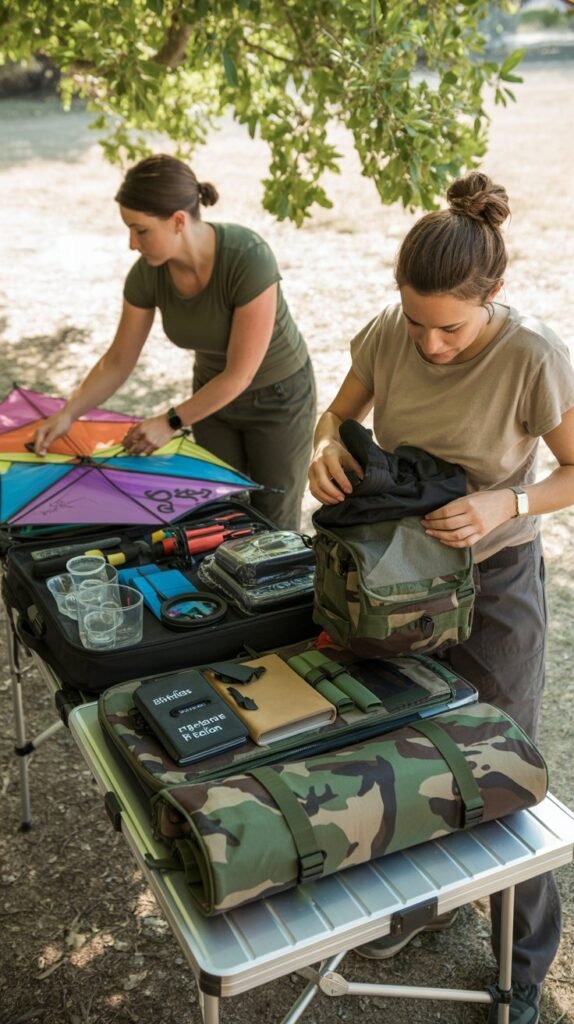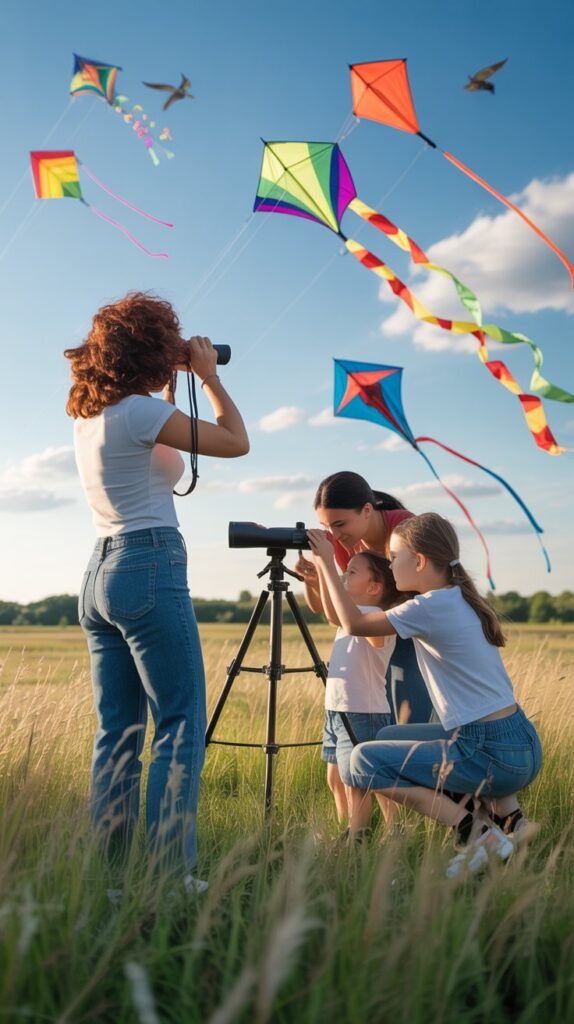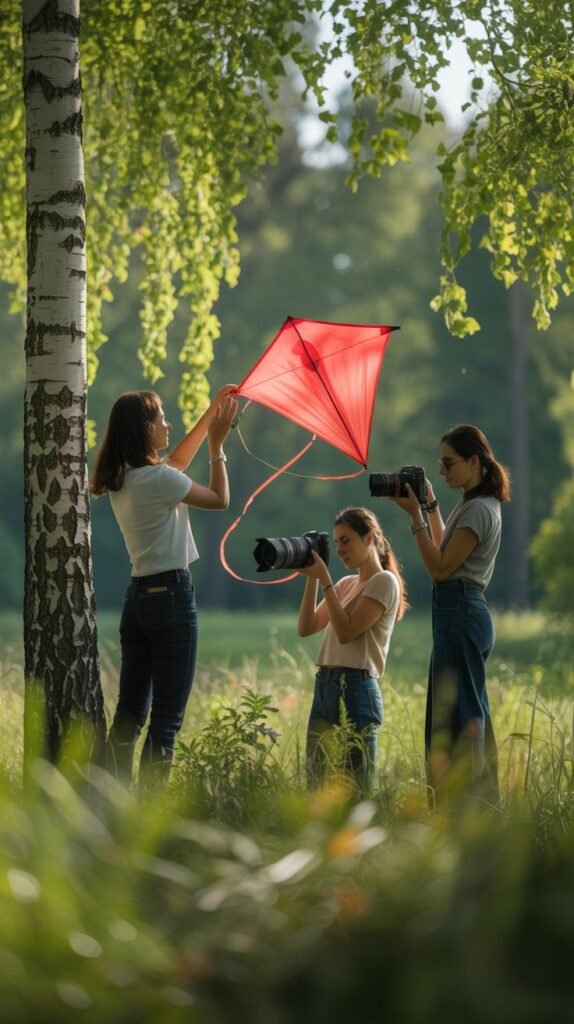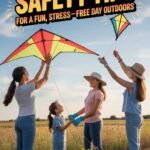Why choose between soaring kites and woodland wonders when you can enjoy both in one magnificent outdoor adventure? Combining a kite picnic with a nature walk creates the perfect balance of active exploration and peaceful relaxation, offering something for everyone in your group regardless of age or interest.
This thoughtfully integrated outing pairs the exhilaration of watching kites dance against the sky with the grounding experience of connecting with nature up close. The combination creates a multi-dimensional adventure that engages all your senses while providing natural breaks in activity that keep everyone energized throughout the day.
Let’s explore how to create the perfect hybrid outdoor experience that maximizes enjoyment while minimizing logistical challenges!
Planning Your Dual-Adventure Outing
Successful combination outings begin with thoughtful planning that addresses the unique requirements of both activities. The key is finding locations and creating schedules that naturally complement rather than compete with each other.
For ideal preparation, focus on:
- Location Scouting: Finding areas with both open flying spaces and interesting natural trails
- Timing Strategy: Planning optimal scheduling for each activity based on conditions
- Group Coordination: Accommodating different interests and energy levels within your party
- Weather Consideration: Selecting dates with conditions suitable for both activities
- Equipment Management: Organizing gear for easy transitions between experiences
What makes hybrid outing planning crucial:
- Compatibility Factors: Not all great kite flying locations offer worthwhile nature walks, and vice versa
- Energy Management: Alternating activities helps prevent fatigue and boredom
- Weather Dependencies: Kite flying and nature observation have different ideal conditions
- Logistical Challenges: Carrying equipment for multiple activities requires strategic planning
- Maximized Enjoyment: Thoughtful scheduling ensures everyone experiences the best of both activities
For successful integration:
- Research locations specifically offering both features, using park websites and outdoor activity apps
- Consider state parks with open meadows adjacent to trail systems
- Check trail difficulty ratings to ensure appropriate challenge levels for your group
- Explore sites with nature centers that offer guided walks or educational materials
- Look for locations with convenient transition points between flying areas and trails
Remember that the goal is seamless integration rather than two entirely separate activities. The best combined outings flow naturally between experiences, with each enhancing rather than detracting from the other.
Selecting the Perfect Dual-Purpose Location
The foundation of your hybrid adventure is finding locations that genuinely excel for both activities rather than compromising on either. The ideal setting offers specific features that support both kite flying and nature exploration while facilitating easy transitions between experiences.
Essential features for perfect dual-purpose locations:
- Open Flying Areas: Spacious, obstacle-free zones with reliable breezes
- Diverse Trail Systems: Paths with varied ecosystems and points of interest
- Convenient Proximity: Close spacing between flying zones and trail access
- Strategic Resting Points: Designated picnic areas near activity transition spots
- Balanced Environments: Neither feature dominating at the expense of the other
What makes location selection crucial:
- Activity Segmentation: Well-designed parks naturally separate active kite areas from quieter nature zones
- Habitat Considerations: The best nature walks feature varied environments supporting diverse wildlife
- Flying Conditions: Not all open spaces offer the consistent, clean wind patterns ideal for kites
- Accessibility Factors: Multiple activities require considerations for different mobility levels
- Amenity Availability: Facilities like restrooms, water sources, and shelter enhance longer combination outings
Exemplary dual-purpose location types:
- Coastal Parks: Offering beach or dune flying with adjacent wetland or maritime forest trails
- Riverside Recreation Areas: Combining open floodplains with riparian woodland paths
- Mountain Meadow Systems: High-elevation open spaces with perimeter woodland trails
- Prairie Preserves: Expansive grasslands with interpretive trails highlighting unique ecosystems
- Lake-Adjacent Parks: Open shorelines for flying with surrounding woodland or wetland walks
For comprehensive evaluation, visit potential locations in advance specifically assessing:
- Wind patterns in flying areas throughout the day
- Trail conditions and difficulty levels
- Natural transition points between activities
- Picnic facilities and their proximity to both activity areas
- Areas of special natural interest for focused exploration
The perfect location allows you to establish a central “base camp” from which both activities are easily accessible, minimizing equipment transportation while maximizing enjoyment of both experiences.
Essential Gear for Dual-Activity Adventures
Equipped with the right gear, your combined outing becomes seamless and enjoyable rather than a logistical challenge. Strategic equipment selection emphasizes versatility, weight management, and easy transitions between activities.
Essential dual-purpose equipment categories:
- Flying Gear: Appropriate kites, lines, and accessories for your location
- Nature Exploration Tools: Observation and identification aids for maximizing trail experiences
- Comfort Essentials: Items that enhance enjoyment during both activities
- Sustenance Supplies: Food and hydration systems suitable for a full day outdoors
- Transition Management: Organization solutions that facilitate activity switching
What makes equipment selection crucial:
- Weight Considerations: Carrying gear for multiple activities quickly becomes burdensome
- Accessibility Needs: Items must be organized for retrieval without complete unpacking
- Multi-Functionality Advantages: Dual-purpose items significantly reduce carrying load
- Weather Adaptability: Equipment must accommodate changing conditions throughout the day
- Group Distribution: Sharing carrying responsibilities requires thoughtful assignment
For optimal equipment management:
- Prioritize Versatility: Select items serving multiple functions across both activities
- Create Modules: Organize gear into activity-specific packages for easy transitions
- Distribute Weight: Assign carrying responsibilities based on participation plans
- Minimize Redundancy: Identify and eliminate duplicate items across categories
- Plan Accessibility: Arrange equipment for retrieval order based on your schedule
Essential multi-purpose items particularly valuable for combination outings:
- Backpacks with removable daypacks for trail exploration
- Convertible hiking poles that double as kite stakes
- Quick-dry, lightweight clothing appropriate for both active movement and sitting
- Multi-compartment hydration systems with filtering capabilities
- Solar chargers supporting both nature photography and wind measurement apps
By thoughtfully selecting and organizing your equipment, you transform what could be a cumbersome burden into a streamlined system that enhances rather than detracts from your connection with both sky and earth.
Crafting the Perfect Hybrid Schedule
The rhythm of your day dramatically impacts enjoyment of both activities. A thoughtfully constructed timeline creates natural flow between experiences while accommodating both environmental conditions and energy levels.
Key scheduling considerations:
- Condition Optimization: Planning each activity for its ideal time of day
- Energy Management: Alternating active and restful periods for sustained enjoyment
- Flexibility Integration: Building in adaptation points for weather or group preferences
- Transition Time Allowance: Scheduling realistic periods for switching between activities
- Natural Break Incorporation: Utilizing meal times as transition opportunities
What makes scheduling crucial:
- Wind Pattern Awareness: Kite flying conditions often improve throughout morning hours
- Wildlife Observation Windows: Many animals are most active in early morning or evening
- Heat Consideration: Strenuous hiking may be better before peak afternoon temperatures
- Attention Span Realities: Younger participants benefit from activity alternation
- Energy Conservation: Strategic rest periods extend overall enjoyment capabilities
Sample optimal schedule structures:
Morning-Focused Flight
- Early Morning: Gentle nature walk during prime wildlife observation time
- Mid-Morning: Transition to kite flying as winds develop
- Noon: Picnic lunch in flying area with casual kite activity
- Early Afternoon: Resume focused kite flying during peak wind conditions
- Late Afternoon: Return to trails for golden-hour nature observation and photography
Afternoon Flight Emphasis
- Early Morning: Extensive nature walk during cooler temperatures
- Mid-Morning: Picnic brunch at transition point
- Late Morning: Short, easy trail exploration nearby
- Early Afternoon: Begin kite flying as thermal winds develop
- Late Afternoon: Peak kite flying during optimal wind conditions
- Sunset: Evening picnic while watching final flights
For successful implementation:
- Create visual timelines accessible to all participants
- Designate a “timekeeper” responsible for smooth transitions
- Establish clear signals for activity changes
- Build in buffer periods for unexpected discoveries or perfect flying conditions
- Remain flexible for weather changes or emerging group preferences
The most successful schedules feel natural rather than rigid, allowing spontaneous moments of joy while ensuring neither activity gets shortchanged in the experience.
Nature-Inspired Kite Flying Activities
Create deeper connections between your two main activities by incorporating nature themes into your kite flying experience. These integrated activities help participants understand the relationship between natural flight and kite aerodynamics while enhancing appreciation for both.
Engaging nature-kite connection activities:
- Bird Flight Comparison: Observing similarities between bird soaring and kite stability
- Nature-Inspired Kite Selection: Flying butterfly, bird, or insect-shaped designs
- Wind Pattern Tracking: Noticing how natural elements reveal air movements affecting kites
- Habitat Height Perspectives: Using kites to gain new viewpoints of the environments explored on foot
- Seasonal Integration: Connecting seasonal changes in both flora/fauna and flying conditions
What makes these integrated activities valuable:
- Educational Enhancement: Provides natural science learning through enjoyable experiences
- Connection Deepening: Creates meaningful links between seemingly separate activities
- Observation Skill Building: Develops attention to detail that improves both experiences
- Engagement Extension: Maintains interest through thematic continuity across activities
- Appreciation Development: Builds understanding of natural principles through direct experience
For successful implementation:
- Research the specific ecosystems of your chosen location before your outing
- Select or decorate kites to reflect local wildlife or natural features
- Create simple observation cards highlighting connections between natural flight and kites
- Prepare questions that encourage participants to notice similarities and differences
- Plan specific moments for guided comparison between natural elements and flying experiences
These integrated activities work particularly well for family groups with mixed ages, as they provide multiple entry points for engagement regardless of prior knowledge or experience level. They transform what might be separate activities into a cohesive exploration of natural principles from different perspectives.
Trail-Friendly Picnic Strategies
The picnic component of your outing requires special consideration when combined with active adventures. Traditional picnic approaches often assume stationary dining, but your hybrid experience demands flexible, portable, and practical food solutions.
Essential trail-friendly picnic approaches:
- Portable Packaging: Utilizing compact, lightweight food storage systems
- Strategic Timing: Planning multiple small meals rather than one large picnic
- Location Flexibility: Preparing for dining in various settings throughout your adventure
- Environmental Consideration: Minimizing waste and impact in natural areas
- Energy Optimization: Selecting foods that support sustained activity
What makes specialized picnic planning crucial:
- Carrying Limitations: Traditional picnic setups become burdensome when combined with activity equipment
- Weather Vulnerability: Outdoor dining plans must adapt to changing conditions
- Activity Interruption: Lengthy meal preparations disrupt flow between adventures
- Energy Requirements: Active outings demand appropriate nutrition timing and selection
- Nature Protection: Wildlife considerations require proper food management and waste control
For successful implementation:
- Prepare individual portion packages that eliminate serving needs
- Select foods requiring minimal utensils and preparation
- Create a mixture of quick-access snacks and more substantial meal options
- Pack multiple smaller water containers rather than fewer large ones
- Establish clear “leave no trace” expectations for all participants
Consider implementing a “rolling picnic” approach with these characteristics:
- Base Camp Supplies: Keeping main food stores at your central location
- Trail Rations: Packing appropriate snacks for nature walks in accessible pockets
- Flying Fuel: Keeping easy-access, one-handed snacks available during kite sessions
- Transition Treats: Planning special refreshments for activity switching times
- Celebration Meal: Saving more elaborate dining for your final activity conclusion
This flexible approach maintains energy levels throughout your adventure while eliminating the logistical challenges of a single large meal that interrupts your activity flow. The distributed eating pattern also creates natural moments for rest and appreciation throughout your experience.
Observation-Enhanced Kite Flying
Apply the detailed observation skills developed during nature walks to enhance your kite flying experience. This cross-activity approach deepens appreciation for flight dynamics while creating continuity between your woodland and open-sky adventures.
Engaging observation enhancement activities:
- Flight Pattern Documentation: Recording and comparing different kite movement styles
- Height Perspective Study: Observing how objects appear different at various altitudes
- Wind Interaction Analysis: Noticing how natural elements respond to the same winds affecting kites
- Cloud Formation Watching: Using kites as reference points for tracking cloud movement and development
- Color Interaction Observation: Studying how kite colors appear against changing sky conditions
What makes observation enhancement valuable:
- Skill Transfer: Nature observation techniques apply beautifully to kite appreciation
- Deeper Engagement: Focused observation transforms casual flying into mindful experience
- Learning Integration: Creates natural opportunities for understanding scientific principles
- Documentation Value: Produces meaningful records of your experience for later reflection
- Attention Development: Builds capacity for sustained, detailed observation across contexts
For successful implementation:
- Provide appropriate tools like binoculars, magnifiers, or viewing scopes
- Create simple observation guides with specific features to notice
- Establish observation stations at strategic viewing points
- Develop questions that promote comparative thinking between natural and kite flight
- Incorporate periods of silent observation followed by group sharing
This approach is particularly valuable for participants who might otherwise consider themselves primarily interested in just one activity. By building bridges between experiences, you help everyone discover new dimensions of enjoyment in both the woodland trails and open sky adventures.
Trail Features That Enhance Kite Flying
Discover how specific trail features can actually enhance rather than detract from your kite flying experience. The natural landscape offers unique opportunities for flying perspectives unavailable in standard open fields.
Valuable trail-kite integration points:
- Elevated Clearings: Natural lookout points providing both scenic views and excellent launch sites
- Forest Edges: Boundary areas creating interesting wind patterns for flying experiments
- Protected Valleys: Sheltered spots offering flying opportunities even on windier days
- Varied Terrains: Differing surfaces creating thermal patterns that affect kite behavior
- Natural Windbreaks: Tree lines providing strategic shelter for comfortable flying bases
What makes trail feature integration valuable:
- Expanded Flying Options: Accessing unique wind conditions unavailable in standard fields
- Protected Environments: Finding suitable flying locations in more varied weather conditions
- Scenic Enhancement: Creating spectacular photographic opportunities with natural backgrounds
- Discovery Encouragement: Motivating fuller exploration of trail systems to find perfect spots
- Environmental Understanding: Building appreciation for how landscape shapes air movement
For successful implementation:
- Research trail maps before your outing to identify potential integration points
- Seek locations with elevation changes offering both views and flying opportunities
- Look for trail systems with varied ecosystems creating different wind patterns
- Identify natural shelter areas that could serve as comfortable observation points
- Consider trails with open water features that create interesting thermal effects
This approach transforms potentially competing landscape needs into complementary experiences, where the varied terrain enhances rather than limits your kite flying options. The resulting adventure offers richer experiences than either activity could provide in isolation.
Nature-Themed Picnic Foods
Enhance the connection between your activities through thematically linked picnic foods that celebrate both nature exploration and kite flying. These creative culinary touches transform necessary refueling into an extension of your adventure themes.
Engaging nature-themed food ideas:
- Wing-Inspired Presentations: Sandwiches shaped like butterflies, birds, or kites
- Trail Mix Storytelling: Custom blends featuring elements from environments you’ve explored
- Color-Coordinated Components: Foods matching the colors of your kites or natural discoveries
- Layer-Representing Arrangements: Stacked foods representing forest layers observed on trails
- Wind-Named Refreshments: Beverages named after different types of winds experienced
What makes themed food valuable:
- Experience Extension: Continues your adventure themes during necessary breaks
- Conversation Promotion: Creates natural discussion points about observations and experiences
- Photography Enhancement: Provides additional memorable documentation opportunities
- Anticipation Building: Generates excitement for each activity transition
- Connection Strengthening: Reinforces the integrated nature of your dual adventure
For successful implementation:
- Prepare simple base foods that can be quickly assembled into themed presentations
- Use cookie cutters or food molds to create nature or kite shapes
- Create food labels connecting menu items to specific trail observations
- Take photos of foods alongside their natural inspirations
- Include identification games connecting foods to discoveries
This approach works especially well for family groups with younger children, who delight in the playful connections while benefiting from the natural discussion about observations and experiences the themed foods inspire. The creative presentations also provide perfect social media-worthy documentation of your innovative outdoor adventure.
Photography Strategies for Dual Adventures
Document your innovative outing through photography techniques that capture the unique combination of experiences. Strategic approaches create visual stories showing connections between your woodland and sky adventures rather than treating them as separate activities.
Engaging dual-adventure photography strategies:
- Transition Sequence Capture: Documenting the journey from trail to flying field as a connected story
- Parallel Element Comparison: Creating side-by-side images showing similar patterns in both contexts
- Scale Play Photography: Using kites to provide perspective on landscape features explored
- Color Theme Documentation: Tracking specific colors appearing across both environments
- Activity Integration Moments: Capturing instances where both elements combine naturally
What makes specialized photography valuable:
- Narrative Creation: Builds visual story showing connections between experiences
- Memory Enhancement: Creates more meaningful documentation for later enjoyment
- Pattern Recognition: Helps participants notice similarities across different contexts
- Sharing Optimization: Produces more engaging content for social media or presentations
- Perspective Alteration: Encourages seeing familiar elements from new viewpoints
For successful implementation:
- Plan specific photography moments within your schedule
- Create a shot list that includes both individual activities and connecting elements
- Establish locations offering visual access to both environments simultaneously
- Consider designating a primary photographer for each activity segment
- Use technological tools like time-lapse or wide-angle lenses to capture broader experiences
This approach transforms what might be fragmented documentation into cohesive visual storytelling that reflects the integrated nature of your adventure. The resulting images provide perfect conversation starters for sharing your experience while reinforcing the connections you’ve discovered between earth and sky exploration.
Conclusion: Creating Memorable Hybrid Adventures
By thoughtfully combining kite flying with nature walks, you’ve created an outdoor experience greater than the sum of its parts. This innovative pairing offers a perfect balance of active exhilaration and quiet discovery, open-sky freedom and woodland intimacy, creating a multidimensional adventure accessible to participants with diverse interests and energy levels.
The beauty of this combined approach lies in its natural complementarity. The skills developed in one context—careful observation, pattern recognition, environmental awareness, and appreciation for natural forces—enhance enjoyment of the other activity. Meanwhile, the contrasting environments provide refreshing changes that keep engagement high throughout your outing.
Perhaps most valuably, this integrated adventure creates unique connection opportunities among participants. Those who might initially prefer one activity over the other discover new perspectives through shared experiences. Conversations naturally develop around observations from both contexts, building bridges between different interests while creating a cohesive group experience.
As you pack up from your day of dual exploration, you’ll notice something special—the memories formed are distinctly richer than those from either activity alone. The varied sensory experiences, the rhythmic alternation between activities, and the unique combinations you’ve discovered create more vivid, lasting impressions that will continue bringing joy long after your adventure concludes.
So gather your specialized gear, find your perfect dual-purpose location, and set out for an innovative outdoor experience that connects earth and sky through your thoughtful participation. The resulting adventure will transform ordinary kite flying and nature walking into an extraordinary journey of discovery that invites everyone to experience the natural world from exciting new perspectives.

